10 Thoughts About Selma
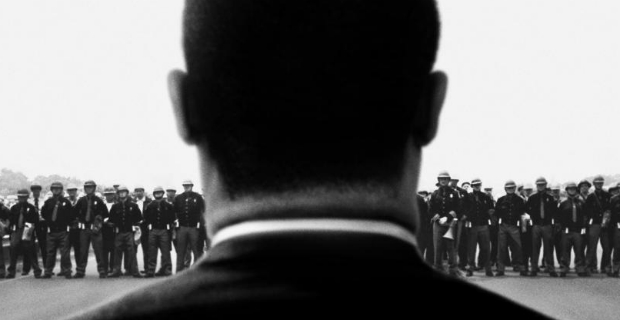 Last week I went to the movie theater to see Selma. I had heard a lot of buzz, but obviously didn’t pay too much attention since going into the movie I thought I would be watching an MLK biopic. The movie actually just focused on MLK’s efforts fighting for civil rights in Selma, Alabama in 1964 and 1965.
Last week I went to the movie theater to see Selma. I had heard a lot of buzz, but obviously didn’t pay too much attention since going into the movie I thought I would be watching an MLK biopic. The movie actually just focused on MLK’s efforts fighting for civil rights in Selma, Alabama in 1964 and 1965.
I first learned about the civil rights movement back in high school. It’s been 15 years since then, but I was still able to recall most of the basic facts and more or less knew the sequence of events portrayed in the film. I’m a highly visual learner though, so the film was able to expand my perspective beyond the dates, speeches, and legislation that I already knew. Here are the thoughts that I came away with:
1. MLK Was An Introvert
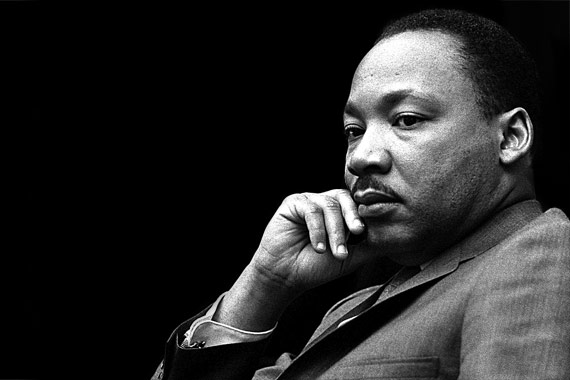 The actor who portrayed MLK did a great job matching the imagine of what MLK is like in my mind in terms of the speeches he gave. However, I was very surprised at how subdued the actor was during MLK’s dialogue scenes. I suppose I’ve never really put too much thought into what MLK was like beyond his stupendous speeches. I assumed that given his public persona, his oratory skills, and his life spent in politics and advocacy that he was an extrovert. After the film, I went and watched a few interviews of MLK and it turns out that the actor was dead on, and MLK was indeed very subdued and appeared to be an introvert when he wasn’t making speeches.
The actor who portrayed MLK did a great job matching the imagine of what MLK is like in my mind in terms of the speeches he gave. However, I was very surprised at how subdued the actor was during MLK’s dialogue scenes. I suppose I’ve never really put too much thought into what MLK was like beyond his stupendous speeches. I assumed that given his public persona, his oratory skills, and his life spent in politics and advocacy that he was an extrovert. After the film, I went and watched a few interviews of MLK and it turns out that the actor was dead on, and MLK was indeed very subdued and appeared to be an introvert when he wasn’t making speeches.
2. Outsider vs Insider
I had a newfound appreciation for MLK’s strategy for achieving change as an outsider. In the movie LBJ offers MLK a cabinet level position, which MLK turns down. While one path to power is certainly through elected office, or holding official titles, it is not the only one. Many people would be tempted accept such an offer, and to to join the establishment. I think MLK was very wise for turning this down, and staying an outsider. As an outsider, MLK was free to pursue social change instead of simply some narrow mandate of a cabinet secretary position. As an outsider, MLK was free to force those in power to face an uncomfortable reality instead of engaging in the dirty work of legislative compromise. As an outsider, MLK wasn’t tied down to one party or one administration, but was free to do his work with whoever he wanted across a longer time horizon.
3. LBJ
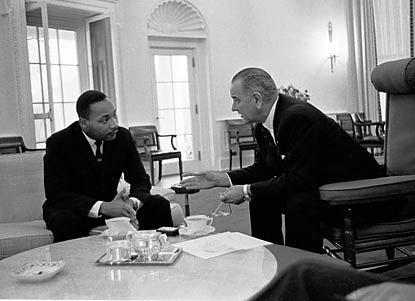 I’m absolutely fascinated with LBJ both in terms of how he wielded power, and his larger than life persona. It was therefore a huge treat for me to get a glimpse at LBJ as president. Despite the fairly consequential historical innacuracies I thought the actor himself was actually quite good. One day, maybe I’ll get around to reading the 3000 page biographical series on LBJ, but until then I’ll have to get my LBJ fix in smaller bits like in Selma.
I’m absolutely fascinated with LBJ both in terms of how he wielded power, and his larger than life persona. It was therefore a huge treat for me to get a glimpse at LBJ as president. Despite the fairly consequential historical innacuracies I thought the actor himself was actually quite good. One day, maybe I’ll get around to reading the 3000 page biographical series on LBJ, but until then I’ll have to get my LBJ fix in smaller bits like in Selma.
4. Intra Civil Rights Movement Factions
When I was learning about MLK’s work back in high school, we focused on his efforts to change the hearts of white citizens and the votes of white politicians. However, the movie made clear that unifying the various activists groups, and the black community in general was equally as important of a task, if not a prerequisite to dealing with white citizens and politicians. The movie didn’t really go too deep into the different factions of the civil rights movement, but there were a few hints of it.
There was a short scene where all of the different Reverends were spoon feeding the audience all of the various voting restrictions that each of them wanted to get rid of first. MLK had to figure out how to focus all of these disparate efforts towards a comprehensive solution. There was also an extremely brief cameo by Malcolm X, who represented a more militant to achieving civil rights for blacks than the nonviolent approach preferred by MLK.
There was also a fascinating scene where the two leaders of the Student Nonviolent Coordinating Committee (SNCC), who had been fighting in Selma for years, were basically subsumed by MLK’s larger organization and asked to take a supportive rather than leadership role. I'm sure that this organizational consolidation was a common occurrence throughout MLK's rise into the leadership role for the civil rights movement. I forget the exact words that MLK used in that meeting, but he outlined his overall strategy for achieving change, and it’s something that I must rewatch, write down and commit to memory.
5. Young John Lewis
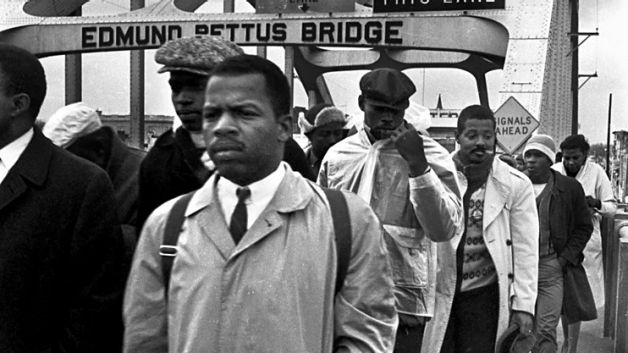 I really liked seeing a young John Lewis during his formative years. When MLK came to Selma, John Lewis was a leader in the SNCC, and eventually would become a close ally of MLK. I only really know about the John Lewis of today, who is an old man that can give real barnburner speeches about the continued need for advancing civil rights in the present time. Seeing John Lewis (among many others) suffering from police brutality for simply crossing a bridge in Selma was very powerful, and really hit home that the civil rights movement isn’t ancient history. It’s something that a lot of people who are alive today lived through.
I really liked seeing a young John Lewis during his formative years. When MLK came to Selma, John Lewis was a leader in the SNCC, and eventually would become a close ally of MLK. I only really know about the John Lewis of today, who is an old man that can give real barnburner speeches about the continued need for advancing civil rights in the present time. Seeing John Lewis (among many others) suffering from police brutality for simply crossing a bridge in Selma was very powerful, and really hit home that the civil rights movement isn’t ancient history. It’s something that a lot of people who are alive today lived through.
6. The Current Supreme Court Is A Disgrace
In one of the worst decisions since Bush v Gore, in 2013 the Supreme Court gutted the the Voting Rights Act of 1965, which was one of the crowning achievement of MLK’s work, and the passage of which was the climax of the film. In this decision Chief Justice John Roberts said that the country had changed, and that it was no longer necessary to protect minority voters in southern states from voter suppression. Of course immediately following this decision all the same states that denied suppressed black voters before the Voting Rights Act responded by implimenting new voting restrictions that would disproprotianely affect minorities and the poor. This just goes to show that MLK's achievements aren't something that we should take for granted as set in stone - they are being chipped away day after day.
7. The Sheer Terror of Being Black in 1965
There were a few scenes that depicted how downright terrifying it was to be a black person in the South back in 1965. I actually thought Oprah’s scene where she tried to register to vote was pretty good. You could see in her face how scared and daring she was for simply being in public and interacting with a white person. While the brutality on the bridge was obviously bad, the most shocking and moving scene of the whole movie was the 16th Street Church bombing that killed 4 young black girls. With police oppression, lynchings, and even bombings - looking back America really used to be a place where there was non-stop domestic terrorism targeting black citizens.
8. Selma Was Really A Court Battle
I had always assumed that the Selma march happened in the same chaotic way that the Berlin Wall fell. With the Berlin Wall a series of events where people started crossing the wall started spreading fast. Eventually this chaos was too much for the authorities, more people started flooding over the wall and then it fell with copious amounts of jubiliation and David Hasselhoff. Contrast this to Selma, where the critical enabler of the march being allowed to finish was decided in an orderly courtroom, not chaos on the ground.
After the first attempt to cross the bridge in Selma ended in horrific violence, the protesters attempted a second crossing. However, as they got to the precipice MLK kneeled down, prayed, and then decided not to try and cross again. Instead they went to court, and ended up winning a legal battle that forced the segregationist Wallace Administration to back down. They were finally able to complete their march the third time around.
9. Yes, Common Was Wearing A Yarmulke
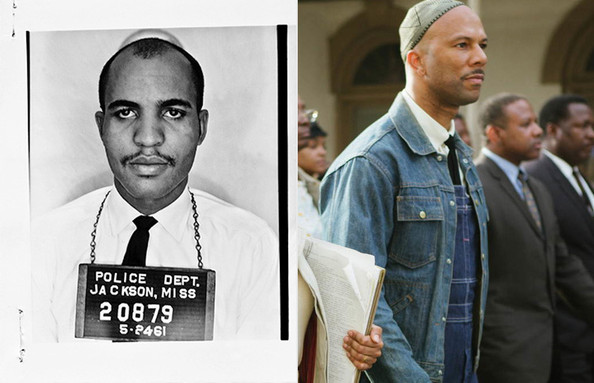 Rap artist Common was wearing a Yarmulke throughout the movie. He was portraying baptist minister James Bevel, who decided to wear a Yarmulke because all of his heros (including Jesus, of course) were Jews who fought for social justice[1].
Rap artist Common was wearing a Yarmulke throughout the movie. He was portraying baptist minister James Bevel, who decided to wear a Yarmulke because all of his heros (including Jesus, of course) were Jews who fought for social justice[1].
10. Thankful For Activists
 I can be fairly critical of our how society is governed, and am always seeking for ways that we can make more progress. However it’s important to step back and remember just how far we’ve come, thanks largely to the efforts of courageous people like the Selma marchers. It was just 50 years ago that the Alabama police brutally beat black citizens for daring to walk over a bridge. Today we have a black President leading the march on Selma’s anniversary to remember the courage of the original marchers. This is what change can look like, if you fight for it.
I can be fairly critical of our how society is governed, and am always seeking for ways that we can make more progress. However it’s important to step back and remember just how far we’ve come, thanks largely to the efforts of courageous people like the Selma marchers. It was just 50 years ago that the Alabama police brutally beat black citizens for daring to walk over a bridge. Today we have a black President leading the march on Selma’s anniversary to remember the courage of the original marchers. This is what change can look like, if you fight for it.
1. See the left column on page 2 of this 1963 Southern Chrisitan Leadership Conference newsletter PDF ↩